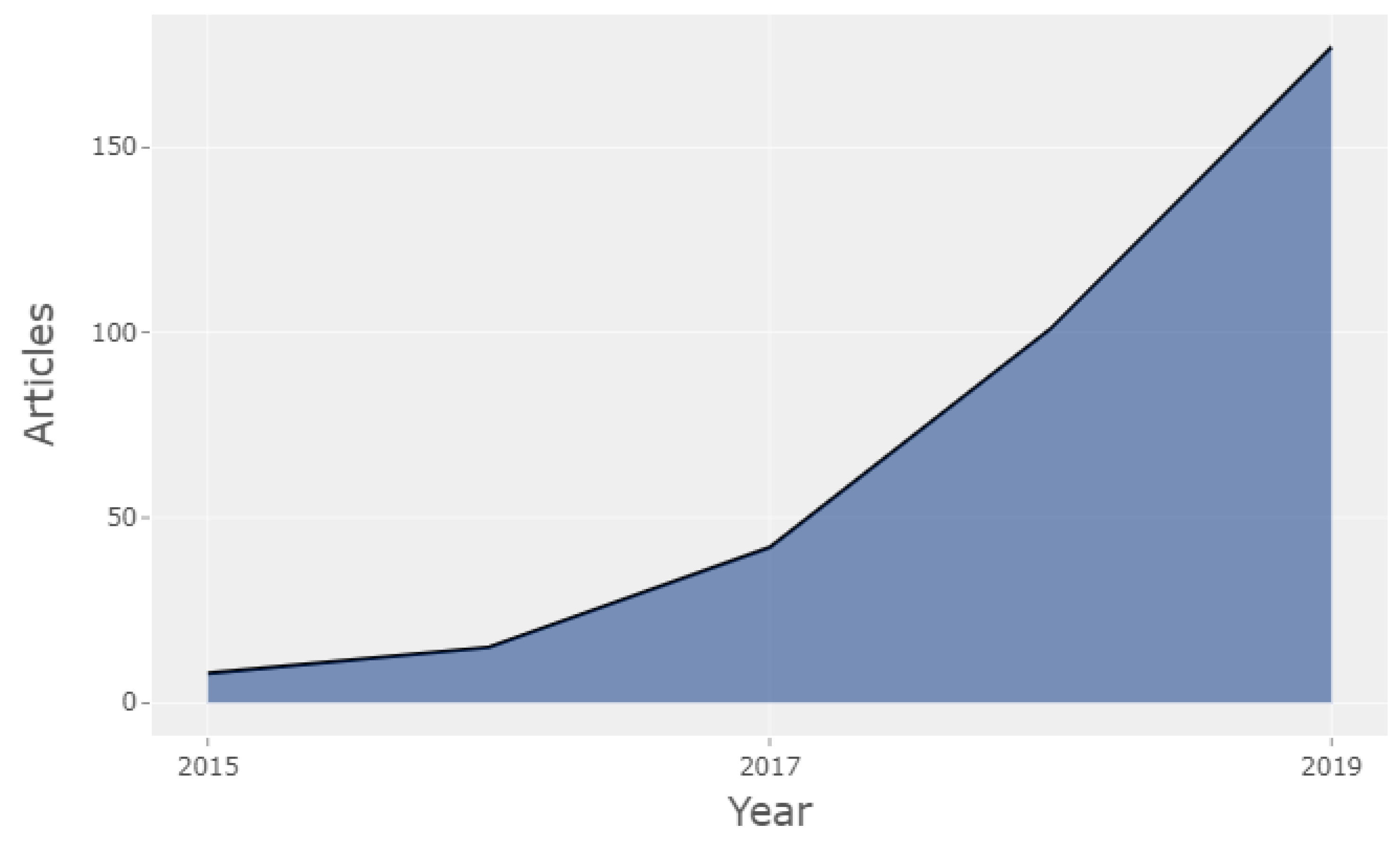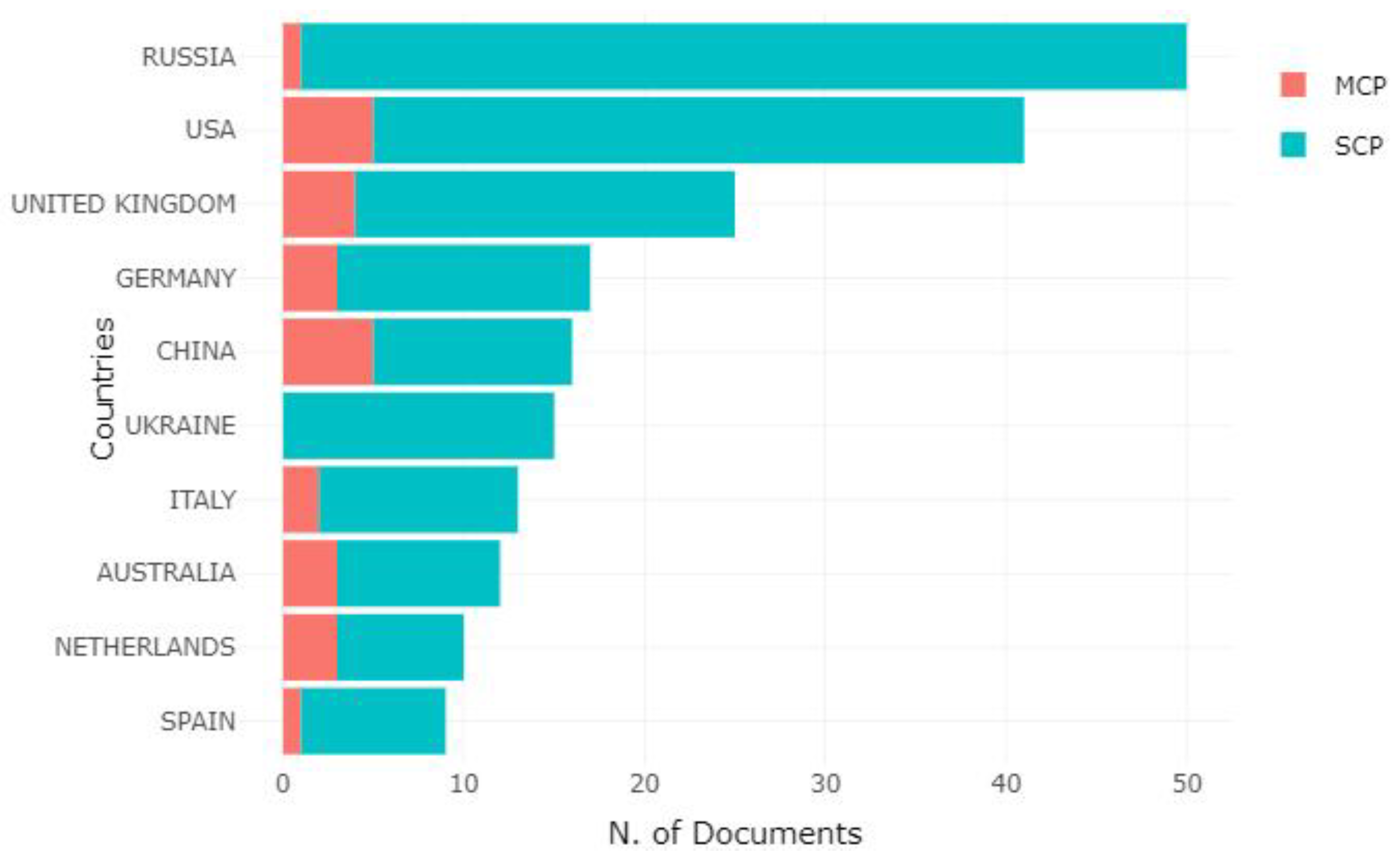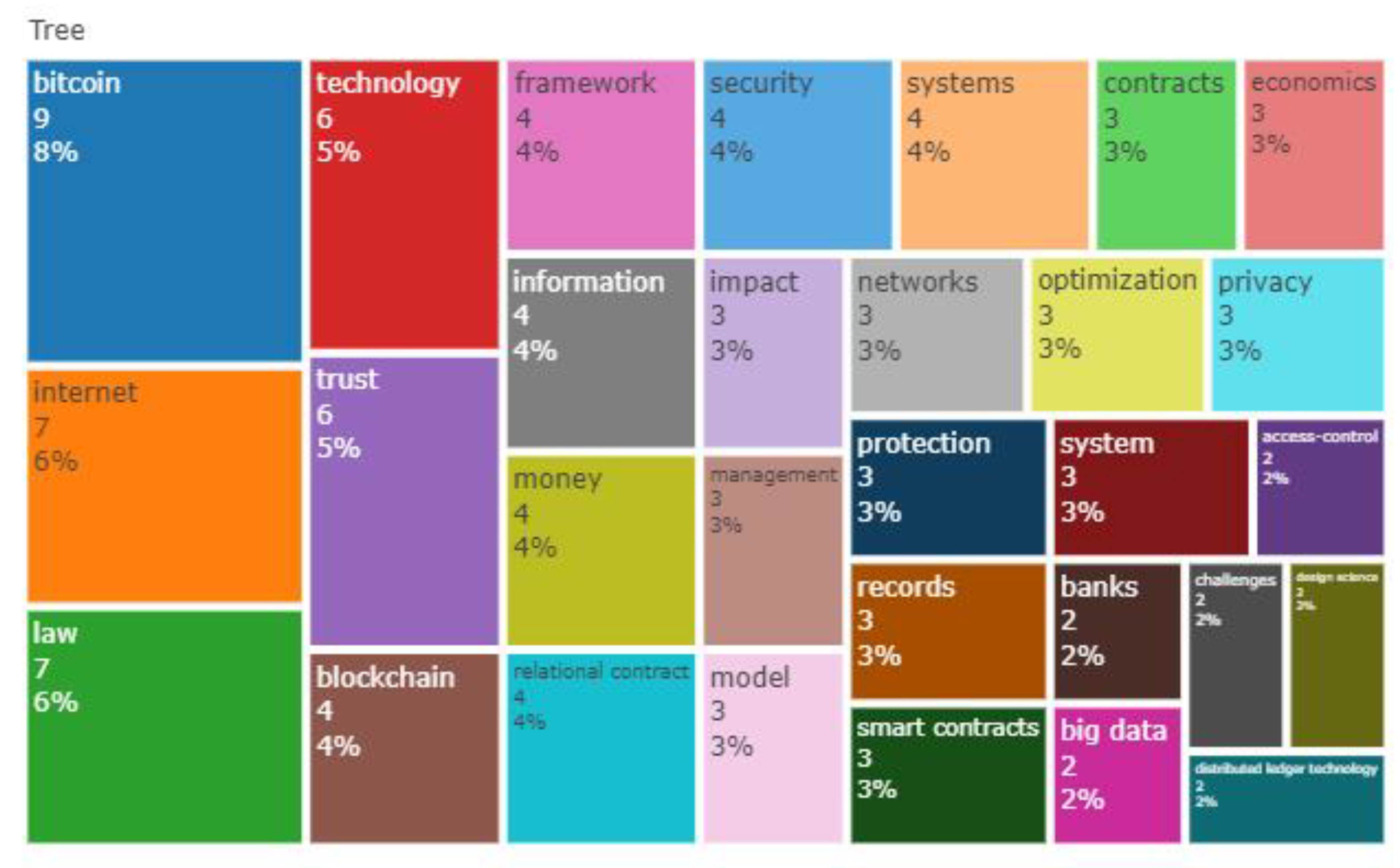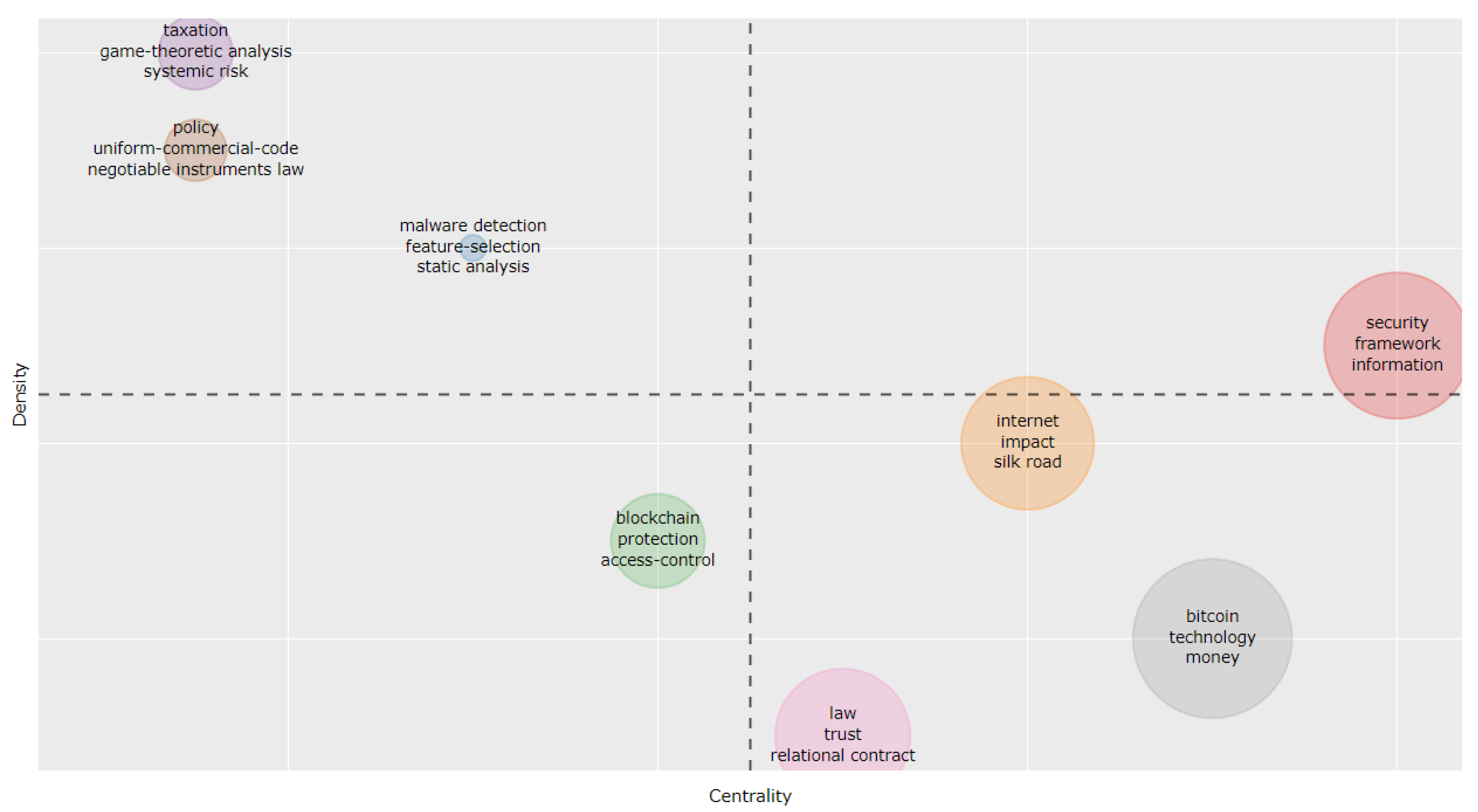1. Introduction
Technological development has contributed decisively to the transformation of the economy and the progress of humanity. Blockchain is one of the technological innovations that present great potential for this progress since it is changing how economic transactions are carried out [
1].
Created by Satoshi Nakamoto in 2008, its initial application was linked to the crypto-currency “Bitcoin, A peer to peer Electronic Cash system”, a peer-to-peer system, through which transactions with crypto-currencies could be executed safely, without having to worry about their authenticity, or if they are spent more than once (double spending) [
2]. Since then, this technology has been evolving and is currently being applied to new types of crypto money such as Ethereum, Ripple, EOS, or Litecoin; as well as in different sectors of society [
3]. In addition, the development of blockchain technology and the incorporation in the financial markets of a vast offer of crypto-currencies and virtual money has led to the creation, expansion, and internationalization of neo-banks, Challenger Banks, BaaS or Fintech, for example, Revolut, N26, Monzo, PayPal Commerce Platform or TransferWise, among others [
4,
5].
Blockchain is defined as a database formed by a decentralized network, distributed and immutable, through which transactions can be made safely, without the need for intermediaries and leaving an incorruptible record [
6].
New concepts are emerging around blockchain technology that challenges any traditional approach, such as Self-sovereign identity (SSI) or Smart Contracts [
7,
8]), and so forth:
Self-sovereign identity (SSI) is based on portable personal repositories where citizens have full control of their data, and where they can store and manage their private keys, authenticators, tokens such as cryptocurrencies, and digital credentials, securely and reliably through a cryptographic process [
9].
Smart Contracts is a new type of self-executing contract based on computer protocols that are designed to automatically facilitate, verify and enforce the negotiation, execution of contracts or flows of digital assets, such as cryptocurrencies [
10,
11,
12], without central authorities [
13].
Although we are in the initial stages of implementation, the interest in this new technology by companies, organizations, and individuals has been growing due to the benefits it can bring: transparency, all those involved have access to consulting the information; security [
14], modifications to the information can only be made by those who are authorized; cost reduction, by eliminating intermediaries; the possibility of carrying out transactions through Smart Contracts [
15]; open innovation, facilitating new forms of relationship between different actors in society [
16,
17,
18].
However, this interest is not only from organizations, in fact, in the scientific community this interest has been increasing in recent years, raising a wide spectrum of research about possible application scenarios in the digital economy and smart industries, including financial services [
19,
20].
Nonetheless, the speed at which new technologies are generated and implemented in today’s information and communication society diverges from the speed of legislators in passing new laws to regulate and protect citizens from these new realities. Blockchain is not alien to this situation and poses legal challenges such as the lack of an owner, the limits of the registration function that they develop, data protection, some aspects about the identity of the participants, or the characterization of crypto-currencies and their relationship with taxes or legal money, among others [
21].
Due to the great interest of society in this new technology, as well as the gap between technological advances, implementation, and legislation, it is necessary to have studies that clarify the main issues related to this new technology and its application [
22]. At present, no study reflects the research recently carried out in this field.
Therefore, the main objective of this work is to analyze the main actors that address research related to the regulation taxation of blockchain, crypto money, and Smart Contracts by using the methodology of bibliometric analysis. Bibliometrics is a part of scientometrics that applies mathematical and statistical methods to all scientific literature and the authors who produce it, intending to study and analyze scientific activity [
23,
24,
25,
26,
27,
28,
29].
This review aims to answer the following research questions:
- ➢
RQ1. Which are the most relevant sources, most local cited sources, authors, author’s affiliations, corresponding author’s, country scientific production and most cited countries in the research on tax regulation in the development of blockchain and cryptocurrencies?
- ➢
RQ2. Which are the most global documents, and thematic and conceptual structure related to research on tax regulation in the development of blockchain and cryptocurrencies?
- ➢
RQ3. Which is the scientific and academic social structure researching the regulation of taxation in the development of blockchain and cryptocurrencies?
The work has been organized as follows:
Section 2 shows the materials, the methodological approach, and the design of the Web of Science search equation;
Section 3 exposes the results of the bibliometric analysis on taxation regulation of blockchain and cryptocurrencies; and finally,
Section 4 contains the discussion, conclusions and the main future lines of research.
3. Results
3.1. Main Information about the Collection
Table 2 describes the main results of the analysis: document type, document content, and author collaboration. The study comprises the period of 2015–2019, yielding a total of 343 documents, with an average of 4437 citations/document, an average of 1,41 citation document/year, and a total of 11,509 references.
The study has shown that articles in scientific journals (193) and communications in conferences/congresses (118) are the document types preferred.
A total of 905 keywords have been used in all the works that make up the study sample. It should be noted that there is a high proportion of individual authors in this type of publication. Of the 349 works recovered, 132 have been written by a single author.
3.2. Annual Scientific Production
Figure 1 shows the annual production volume (2015–2019) of research on tax regulation in blockchain and crypto money. The research in this area has experimented with exponential growth of 116.88%. In ascending order: 2015 (with 8 articles published), 2016 (15 articles), 2017 (42 articles), 2018 (101 articles), and 2019 (177 articles).
3.3. Most Relevant Sources
Table 3 shows the most relevant academic-scientific sources on blockchain tax regulation and crypto-currency development. Within the Top 5 we find in 1st position the COMPUTER LAW AND SECURITY REVIEW with 15 published articles; followed in 2nd position by the JOURNAL EUROPEAN REVIEW OF PRIVATE LAW with 7 studies; in 3rd position the BALTIC JOURNAL OF ECONOMIC STUDIES with 6 studies; in 4th position the RUSSIAN JOURNAL OF CRIMINOLOGY with 5 studies; and in 5th position the UBIQUITOUS COMPUTING AND THE INTERNET OF THINGS with 5 published studies. SCImago Journal Rank (SJR) and Journal Citation Reports (JCR) categories and quartiles of the resulting sources were identified. From the selection of sources, we found that only one source (COMPUTER LAW&SECURITY REVIEW (CL&SR)) is included in the JCR.) However, four sources are included in SJR (in this case, CL&SR, RUSSIAN JOURNAL OF CRIMINOLOGY, UNIFORM LAW REVIEW and BRICS LAW JOURNAL). The sources belong to the following categories: Business, Management, and Accounting; Computer Networks and Communications; Law; and Sociology and Political Science.
3.4. Most Local Cited Sources (from Reference Lists)
Table 4 shows the times that a document or source included in this collection has been cited by other authors in the collection as well. Within the Top 5, we find in 1st position we find the LECTURE NOTES COMPUTER SCIENCE appearing in 124 research papers, followed in 2nd position by the BITCOIN PEER TO PEER (112 papers), in 3rd position the FORBES (69 papers), in 4th position the IEEE ACCESS (51 papers), and finally in 5th position the JOURNAL OF MEDICAL SYSTEMS with 49 papers.
3.5. Source Local Impact (H-Index)
Table 5 shows the scientific journals with the highest impact, using the H-Index as an impact comparative parameter [
38]. The journals with the highest impact coincide with
Table 3, which showed the journals with the highest number of studies published on blockchain tax regulation and the development of cryptocurrencies. Within the Top 5, In ascending order by the number of publications, we find the journal COMPUTER LAW AND SECURITY REVIEW, the 1st one of the ranking, with an H-Index of 7, which means that the journal has 7 studies that have been cited at least 7 times, a total of 193 citations and 15 publications (starting with publications of the mentioned subject in the year 2017), followed in 2nd position by the EUROPEAN REVIEW OF PRIVATE LAW (2 H-Index, 10 citations and 7 documents), in 3rd position the BALTIC JOURNAL OF ECONOMIC STUDIES (also 2 H-Index, 12 citations and 6 documents), in 4th position the RUSSIAN JOURNAL OF CRIMINOLOGY (1 H-Index, 3 citations and 5 documents), and finally in 5th position the UBIQUITOUS COMPUTING AND THE INTERNET OF THINGS: PREREQUISITES FOR THE DEVELOPMENT OF ICT (0 H-Index, 0 citations and 5 documents).
3.6. Authors’ Local Impact
Table 6 shows the impact of authorship. Within the Top 3, we find the author SAVELYEV A has published 3 scientific works related to tax regulation in cryptocurrencies and the development of blockchain and these three works have received a minimum of 3 citations, so it has an H-Index of 3 and a total number of citations of 89. It is followed by the authors DROZD O and GOVERNATORI G, both with an H-Index of 2.
3.7. Most Relevant Affiliations
Table 7 shows the classification of scientific production by author’s affiliation. Two university rankings are used for comparison: the 2019 Quacquarelli Symonds (QS) World University Rankings and the 2019 Academic Ranking of World Universities (ARWU) [
39].
We can highlight, in order of participation: THE INSTITUTE OF LEGISLATION AND COMPARATIVE LAW (RUSSIA), followed in 2nd position by the NATIONAL ACADEMY OF INTERNAL AFFAIRS (UKRAINE), in 3rd position THE RESEARCH INSTITUTE OF INDUSTRIAL ECONOMICS (SWEDEN), in 4th position the SWINBURNE UNIVERSITY OF TECHNOLOGY (AUSTRALIA), in 5th position THE TALLINN UNIVERSITY OF TECHNOLOGY (ESTONIA), in 6th position the URAL STATE UNIVERSITY OF ECONOMICS (RUSSIA), in 7th position the VOLGOGRAD STATE UNIVERSITY (RUSSIA), in 8th position the CHINESE UNIVERSITY OF HONG KONG (HONG KONG), in 9th position THE DELFT UNIVERSITY TECHNOLOGY (THE NETHERLANDS), and finally in 10th position the KAZAN FEDERAL UNIVERSITY (RUSSIA).
The results reveal that within this classification of influential affiliations, 40% of them belong to the Russian Federation. The most productive organizations in research on tax legislation in blockchain and cryptocurrency are not part of either of the two international rankings of quality and university evaluation ARWU and QS (1st to 3rd position) and only the universities of HONG KONG (8th position) and THE NETHERLANDS (9th position) stand out with relevant positions in the international university rankings.
3.8. Corresponding Authors’ Countries
Figure 2 and
Table 8 shows the country of the corresponding authors. The corresponding author is the author who sends the article to the journal editor and channels all correspondence with him; also, his e-mail address usually appears on the first page of the article, acting as a contact author with other interested researchers [
40]. Within the Top 3 we find in the 1st place Russia, which has published a total of 50 papers where the corresponding author was a Russia-based researcher, followed in 2nd position by the USA with 41 published papers with 41 corresponding America-based authors, and in 3rd position the United Kingdom with 25 papers and 25 UK-based corresponding authors. The ones with the highest rates of international collaboration are the USA, UK, Germany, and China. However, Russia being the first country in volume of correspondence authors, strangely does not have many international collaborations; the same happens with Ukraine, with a lot of scientific production and no intra-collaboration.
3.9. Country Scientific Production
Figure 3 and
Table 9 shows the distribution of scientific production frequencies worldwide by the affiliation country. Within the Top 5, we appreciate how RUSSIA in 1st position (159 freq.) and the USA in 2nd position (115 freq.) stands out on the hegemony of academic-scientific production, followed in the 3rd position by the UK (freq.), in 4th position CHINA (62 freq.) and 5th position UKRAINE (51 freq.).
3.10. Most Cited Countries
Table 10 shows the total number of citations received by the different countries in the selected study sample. In descending order, we find within the Top 3, in the 1st position the USA, being the first preference by authors when it comes to reference works in the selection made of 343 documents (with a total number of citations of 388 and average of 9.43). In 2nd position, we find that CHINA was the second option for authors to cite references in their works (reaching a total of 180 citations and an average of 11.25). Finally, in 3rd place, we find the UK (with a total of 129 citations and an average of 5.16).
3.11. Most Global Cited Documents
Table 11 shows the selection of the most cited articles in taxation regulation on blockchain and cryptocurrencies.
Within the Top 3, in total citation descending order, we find in the 1st place the work of KSHETRI N [
14] entitled “
Blockchain’s roles in strengthening cybersecurity and protecting privacy”. The article provides a comprehensive analysis and explanation of blockchain’s roles in tracking the sources of insecurity in supply chains related to IoT devices and delves into how blockchain can make it possible to contain an IoT security breach in a targeted way after it is revealed.
In the 2nd position, we find the work of KIVIAT TI [
41] entitled “
Beyond Bitcoin: Issues in Regulating Blockchain Transactions”. The work examines the application of blockchain in the financial sector, through the use of virtual currencies, such as Bitcoin, addressing its characteristics and the possibility of making transactions more efficiently, without the need for a central institution and under the control of each user. In addition, the work raises several questions regarding the legal regulation of these transactions.
By the end, in the 3rd position, we find the work of ZHAO JL et al. [
20] entitled “
Overview of business innovations and research opportunities in Blockchain and introduction to the special issue”. The authors give an overview of blockchain research and development by showing that blockchain has enabled Bitcoin, the most successful digital currency, and its widespread adoption in finance and analyses how other business sectors will empower many business innovations as well as many research opportunities.
3.12. Keyword Plus TreeMap
The terminology associated with tax regulation in the development of blockchain and crypto-currency taxes can be seen in
Figure 4. We found that some of the most frequent terms are blockchain (freq. 9), internet (freq. 7), law (freq. 7) technology (freq. 6), or trust (freq. 6). The terms that have been used to a lesser extent have been access-control (freq. 2) or distributed ledger technology (freq. 2), among others.
3.13. Thematic Map: Strategic Diagram
Figure 5 shows the structure of the strategic diagram of the analysis performed. The
x-axis shows the density, which measures the proportion of relationships present in it concerning the maximum number of relationships that can exist. The density of each group’s network varies within a range from 0 to 1, where a value of zero means that no relationship exists between group members, while a value of one means that all group members are related to each other, being the maximum level of relationship that can exist between group members [
47].
The ordinate axis shows centrality, which is the property that identifies the nodes with the highest number of links within a network [
47]. More central actors may have an advantageous position concerning others in the sense that they have more alternatives to satisfy their needs, more possibilities of access to resources, and are considered less dependent.
The strategic diagram represents four quadrants 4: Motor Themes; Peripheral and Marginal Themes; Emerging or Disappearing Themes; and Generic and Transversal Themes.
Driving Themes: Represented in the upper right quadrant, driving themes refer to well-developed and important themes. The study has identified a cluster consisting of three sub-themes: security, framework, and information. These themes are of particular importance for the construction of the scientific field due to their strong centrality and high density.
Peripheral and Marginal Themes: Represented in the upper left quadrant, these themes refer to peripheral and marginal themes. The study has identified three clusters with the following sub-themes: Cluster 1, Taxation, game-theoretical analysis and systemic risk. Cluster 2. Policy, uniform-commercial-code, and negotiable instruments law; Finally, Cluster 3. Malware detection, feature-selection, and static analysis. These topics are well developed internally, however, they are isolated from the rest of the topics, having marginal importance within the scientific field.
Emerging or Disappearing Themes: Represented in the lower left quadrant, emerging, or disappearing themes refer to underdeveloped themes or in the process of disappearing. The analysis has shown an emerging cluster with three sub-themes: Blockchain, protection and Access-control.
Generic and Transversal Themes: Represented in the lower right quadrant are the basic and transversal themes of the scientific field analyzed. The analysis has shown three clusters with the following sub-themes: cluster 1, internet, impact, and silk road; Cluster 2, formed by bitcoin, money, and technology; Finally, Cluster 3, law, trust, and relational contract. These topics are basic and are not well developed, however, they are important for the scientific field.
3.14. Social Structure: Collaboration Network (Countries)
Figure 6 shows the social structure represented by a country collaboration network that produces research related to tax regulation on cryptocurrencies and blockchain and the generated collaborative networks. Although many countries publish on the subject, only a small collaboration cluster can be distinguished. The cluster comprises the following countries: USA, United Kingdom, Germany, China, Italy, Australia, The Netherlands, Indonesia, Canada, Switzerland, Greece, and Estonia. The study demonstrates, that despite identifying a significant number of countries working on the studied issues, there is no representative structure of collaboration patterns between them. In this sense, Russia stands out as the country with the greatest number of publications in this field, but it does not present collaborations with other countries.











